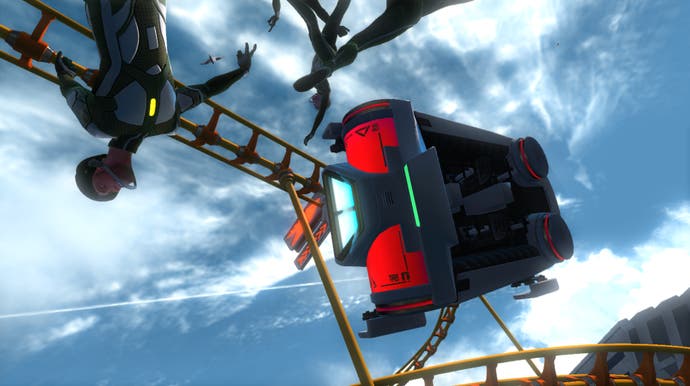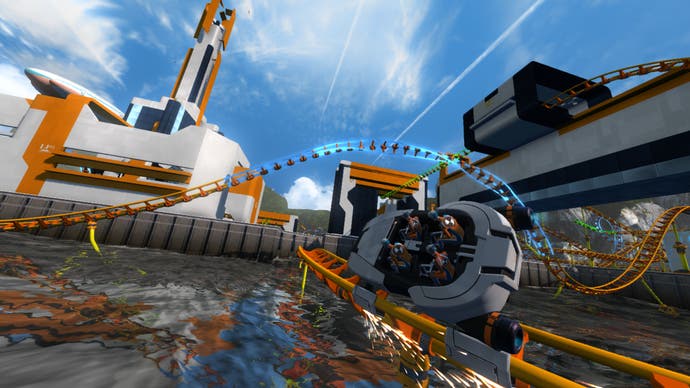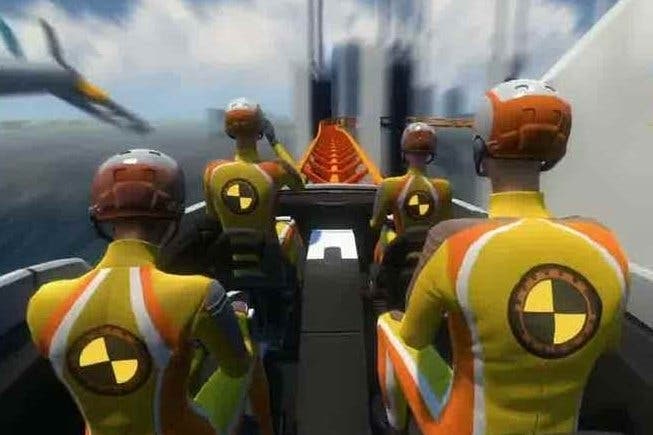Screamride review
Disneybland.
Frontier has been quietly cornering the market in theme park builders of late, with the likes of Coaster Crazy and Thrillville: Off The Rails - not forgetting, of course, the evergreen Rollercoaster Tycoon 3. Screamride, however, has the fingerprints of publisher Microsoft all over it. The fat-headed, projectile puking thrill-seekers of the developer's most recent efforts have been replaced by a series of gawky avatars and a robot narrator who sounds like the love child of GlaDOS and NintendoLand's Monita. These aren't ruinous changes, obviously, but they're part of a sterile, near-future aesthetic that saps some of the life from an otherwise solidly entertaining family game. It's most obvious in the Demolition Expert mode, one of three roles you'll adopt during your Screamride career. Here, you're asked to destroy a series of test facilities, usually by hurling a cabin from a giant rotating launcher, or occasionally firing a coaster car into them. The physics are perfectly robust, and the challenges come with plenty of wrinkles: bonus objectives might ask you to pass through three hoops, or to bounce off five trampolines while achieving a given points tally. There's strategy involved, too. Sometimes your targets will be blocked by indestructible barriers, or you'll have to topple structures like dominoes to score big. The act of launching can seem fiddly and awkward at first, but a generous degree of aftertouch allows you to correct wayward throws.
The main issue is that none of it feels real. The facilities remind me of those ludicrously opulent hotels built on Dubai's artificial islands: they exist, yet they seem strangely impossible. The structures here don't really look like they ever housed anyone; they're just buildings designed to be demolished, and that's even clearer when your cabin crashes through the exterior and triggers a blast from some explosives hidden within. The extensive chain reaction that follows might look impressive, but you don't always feel like you had much to do with it.

That isn't always the case, and the best stages essentially turn you into a wrecking ball without the chain. And when you're given a winged coaster, you're encouraged to break the habit of a lifetime by not weaving between buildings but ploughing straight into them. So it's a pity that as you progress you'll find stages growing increasingly restrictive - limiting the speed of your throw forces you to take prescribed routes, bouncing from trampolines to giant magnets which allow you to take aim from a more favourable angle (which has the knock-on effect of making the initial launch feel less meaningful). It's all a little too clean and controlled, a corporate-approved brand of destruction that lacks the potency of its peers. The narration hardly helps - "structural integrity compromised" is a decidedly underwhelming way to celebrate the moment you collapsed a skyscraper onto a passing speedboat.
Engineer mode fares better. Here, you're asked you to build coasters to certain specifications, while working within strict limits. In most cases, several pieces have already been placed and can't be changed, and it's your job to fill in the gaps while achieving the given criteria for success, whether it's reaching a given top speed, or keeping the nausea level of your riders below a certain level. Throw in too many loops and corkscrews and the lateral G-forces might cause testers to fly off - there's a bonus for keeping everyone in the car, though oddly you'll also earn points for everyone who didn't make it to the finish.
The controls here are wonderfully intuitive, such that a tutorial almost seems unnecessary. An auto-complete function handily joins up two ends you might be struggling to link, and making small adjustments after failed tests is a doddle. Boosters and brakes allow you a greater degree of control over the pace of your ride, which is ideal for stages like the one where giant mechanical contraptions threaten to spoil the fun. The only gripe here is with the stages that invite you to build a coaster to destroy buildings. The authentically unpredictable physics means that two consecutive tries with identical tracks can yield wildly different results - or at least the difference between a three and a four-star rating.
Your final job option is Screamrider, an on-rails racer which overcomes its rather unpromising premise to become arguably the most interesting third of the Career mode. Though it lacks the exhilarating speed of an F-Zero, say, it's enjoyably tactical: do you lean into corners to remain on the track, or lift two wheels off to score bonus points, at risk of derailing and losing valuable time? During blue portions of the track you can top up your boost meter: the closer to the end you press the X button, the more your gauge will be replenished. If the ideal strategy remains broadly similar throughout - boost during climbs and slow sections, brake only on sharp turns - the increasing complexity of the track designs and the additional variables to consider keep things fresh. The steering may be automated, but monorails, track blockers and jumps give you plenty to think about as you hurtle along.

Once you're done with the Career - the six stops on your globe-hopping adventure should take you a good weekend's play to get through - there's Sandbox mode, a bewilderingly comprehensive level creator that allows you to build stages fitting any of the three game types and share them online. There's an astonishing degree of freedom here - you can choose your own score targets, set bonus objectives and even position drone cameras to provide an overview of the stage before you start, or to offer the perfect angle to watch the unfolding destruction (indeed, you can make a better fist of it than Frontier, which sometimes hides its most spectacular detonations behind barriers).
If you're creating a ride there's a wide selection of presets including trebuchets, ballistae and telescopic launchers, and if none of them quite tickles your fancy, you can build your own piece by piece, choosing between rotators or hinges, pistons or sliders. As an example of the granularity of the options, I was able to build a hinged mechanism with alternating movement, which flicked forward and back quickly, but paused for a couple of seconds in between. You can even adjust the timer setting on the cabin release attachment.
Whether many players will bother to tinker to that extent remains to be seen, because it's only through experimentation that I even found these options. It's here that the limitations of Engineer mode are laid bare, because what should be the ideal tutorial for Sandbox mode scarcely covers the basics. Building a coaster may be relatively straightforward, even if you skip the later missions, and not least because there's no need to build any islands first. But constructing a launcher is a far more time-consuming undertaking, for which you're given little assistance; rather than practical lessons, you're simply presented with a series of tutorial screens. Blueprints for buildings speed things along a little - and you can save and share your own painstakingly assembled structures to help other players - but it's easy to see a lot of budding builders being discouraged by the lack of meaningful instruction. It's a few minor tweaks away from something special, and the same applies to Screamride as a whole. While there's nothing in Frontier's latest to make your stomach churn - with the possible exception of its honkingly awful dubstep soundtrack - there's not quite enough here to get your pulse racing either.

